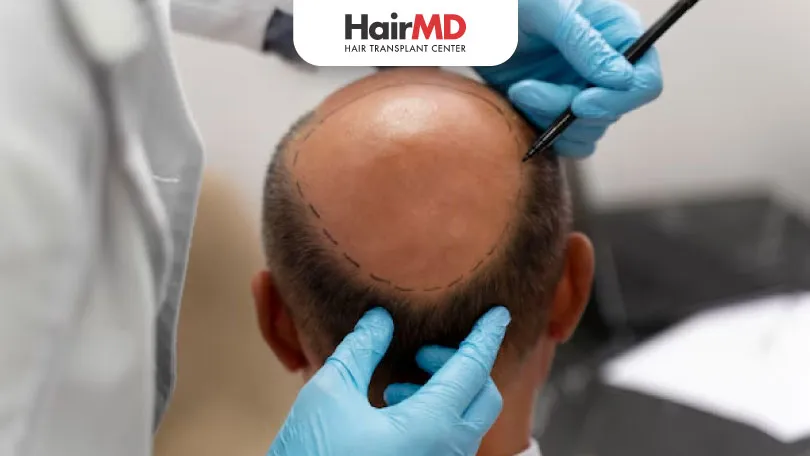13th August, 2021

Hair transplants have become a popular solution for hair loss, but the process comes with many questions. In this blog, HairMD Pune addresses advanced FAQs surrounding hair transplants, providing clear insights into key topics like why patients must use their own hair, the science behind donor dominance, and the limitations of using others’ or artificial hair.
If you’re considering a transplant, this guide will help you understand the critical aspects of the procedure, ensuring a well-informed decision for your hair restoration journey.
What’s covered in the article?
- Why you are your own donor for a hair transplant?
- Why we need our own hair for transplant?
- Why can’t we transplant other’s hair or artificial hair?
- Why can’t we get others hair after group matching as we can in kidney or liver transplant?
- What is the donor area and why hair from the donor area won’t fall out when transplanted in the recipient area?
- What is The Donor Dominance theory?
- Why body hair won’t fall out in the recipient area?
- Conclusion
Why you are your own donor for a hair transplant?
If you are having hair loss problem and suffering since for a long time? So, finally you have decided to get a hair transplant done, but still, you have lots of questions on your mind. One of the most common questions running through your mind is like – why we are your own donor for a hair transplant, how to sleep after a hair transplant and when hairs will grow etc. I will give you complete information about why we need our own hairs for hair transplant and its importance.
Why we need our own hair for transplant?
There is very less chance of rejection when one takes their own hair for hair transplant. The hair taken from the back of the scalp ensures uniform hair growth throughout the scalp. The maximum that one can go as far as the limit of a hair transplant is concerned is to have body hair used as donor’s hair.
Why can’t we transplant other’s hair
or artificial hair?
When one donates hair, it comes with a lot of responsibility. One needs to have various medications to get their immunity sorted. Even though it technically seems possible, but there is no hair transplant surgeon who ever risks taking hair from other’s original or artificial hair. Also, it is extremely difficult to get donor hair that exactly matches the potential hair required for hair transplant. The anti-rejection medication is a lot to take for entire life and hence too much to ask for.
Why can’t we get others hair after group matching
as we can in kidney or liver transplant?
Even though the technique seems quite similar, but the problems that come with the usage of other’s hair for a hair transplant is very different. The main issue is the requirement for the constant intake of immunosuppressants which lower one’s natural immune response, and increases one’s susceptibility to various infections and even cancer. You need to take them for the rest of your life making you dependant on them forever.
When we consider a transplant using someone else’s hair, it is also not only unfeasible but highly undesirable as well for aesthetic reasons. The hairstyle, the texture, the thickness and the color, all are different with different individuals. When you are trying to find the right donor whose hair would match all of the aforementioned criterions is nearly impossible.
What is the donor area and why hair from donor area won’t fall out when transplanted in recipient area?
Your donor area is generally the zone behind the scalp and the recipient area is the hairline. The donor area is quite strong in its roots and grows back naturally. It is quite desirable to place this hair on the recipient area so as to ensure uniformity and also to have the same texture and color.
What is The Donor Dominance theory?
The Donor Dominance Theory states that the hair placed in the recipient area retain the main characteristics of the donor’s hair and continue to have the same growth. Thus the underlying principle of hair transplant has been used since ages.
Watch what our hair transplant surgeon, Dr. Shivanee has to say about the impact of donor dominance in hair transplant.
Why body hair won’t fall out in the recipient area?
The logic behind this is the same as the logic applied for donor hair area. If you choose to use the same hair as your body growth for your recipient area, then you will choose hair that is extremely strong in growth and roots.
Do You Know?
Nearly 250 Patients Visit HairMD
Everyday For Various Hair Concerns?
(You are one click away from flawless skin)
Meet Our Dermatologists
Conclusion
We have given you complete information regarding why we can’t use other donor hairs for hair transplant. You can comment us also we will be happy to help you out.
In conclusion, understanding the intricacies of hair transplant procedures, from donor hair selection to the limitations of artificial hair, is crucial for anyone considering this solution for hair loss. By addressing these advanced FAQs, HairMD Pune provides valuable insights that can help patients make informed decisions about their treatment options. Always consult with a qualified specialist to tailor the procedure to your individual needs and achieve the best results.
Further Reading
Shedding Phase After Hair Transplant
Discover essential medications post-hair transplant like finasteride and minoxidil. Learn tips for care and recovery from HairMD Pune experts.
What medications should be taken after a hair transplant?
Discover essential medications post-hair transplant like finasteride and minoxidil. Learn tips for care and recovery from HairMD Pune experts.
Side Effects of Hair Transplant: Insights from Dermatologist
Discover the side effects of hair transplant surgery, preparation tips, and long-term benefits with insights from Dr. Sachin Pawar at HairMD Pune.
Understanding Hair Transplant Results: Simple Guide for Patients
Explore hair transplant results, recovery phases, regrowth, & post-care tips to achieve natural-looking results. expert advice at HairMD
Have thoughts? Please let us know
We are committed not only to treating you, but also educating you.











